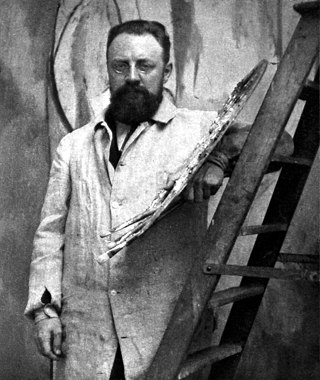Related Research Articles

Jules Henri Poincaré was a French mathematician, theoretical physicist, engineer, and philosopher of science. He is often described as a polymath, and in mathematics as "The Last Universalist", since he excelled in all fields of the discipline as it existed during his lifetime. He has further been called "the Gauss of modern mathematics". Due to his success in science, along with his influence and philosophy, he has been called "the philosopher par excellence of modern science."

Henry IV, also known by the epithets Good King Henry or Henry the Great, was King of Navarre from 1572 and King of France from 1589 to 1610. He was the first monarch of France from the House of Bourbon, a cadet branch of the Capetian dynasty. He pragmatically balanced the interests of the Catholic and Protestant parties in France, as well as among the European states. He was assassinated in Paris in 1610 by a Catholic zealot, and was succeeded by his son Louis XIII.

Henri Émile Benoît Matisse was a French visual artist, known for both his use of colour and his fluid and original draughtsmanship. He was a draughtsman, printmaker, and sculptor, but is known primarily as a painter.

Comte Henri Marie Raymond de Toulouse-Lautrec-Monfa, known as Toulouse-Lautrec, was a French painter, printmaker, draughtsman, caricaturist, and illustrator whose immersion in the colourful and theatrical life of Paris in the late 19th century allowed him to produce a collection of enticing, elegant, and provocative images of the sometimes decadent affairs of those times.

Henri, Count of Chambord and Duke of Bordeaux, was the Legitimist pretender to the throne of France as Henri V from 1844 until his death in 1883.

Henri is Grand Duke of Luxembourg, reigning since 2000. He is the eldest son of Grand Duke Jean and Princess Joséphine-Charlotte of Belgium, as well as a first cousin of King Philippe of Belgium. In 2019, his net worth was estimated around US$4 billion.

Henri Cartier-Bresson was a French artist and humanist photographer considered a master of candid photography, and an early user of 35mm film. He pioneered the genre of street photography, and viewed photography as capturing a decisive moment.

Henri Julien Félix Rousseau was a French post-impressionist painter in the Naïve or Primitive manner. He was also known as Le Douanier, a humorous description of his occupation as a toll and tax collector. He started painting seriously in his early forties; by age 49, he retired from his job to work on his art full-time.
Events from the year 1870 in art.

Louis Edmond Duranty was a prolific French novelist and art critic.

Café Guerbois, on Avenue de Clichy in Paris, was the site of late 19th-century discussions and planning amongst artists, writers and art lovers – the bohèmes (bohemians), in contrast to the bourgeois.

Charles Angrand was a French artist who gained renown for his Neo-Impressionist paintings and drawings. He was an important member of the Parisian avant-garde art scene in the late 1880s and early 1890s.

Three Faces of Sin is a 1961 French language motion picture comedy directed by François Villiers, based on the novel by Jean-Jacques Gautier. The music score is by Maurice Jarre. The film stars Michèle Morgan, Jean-Claude Brialy, Catherine Spaak and Scilla Gabel.

Paul Camille Guigou was a French landscape painter.

A Studio at Les Batignolles is an oil-on-canvas painting by French Impressionist painter and lithographer Henri Fantin-Latour, created in 1870. It depicts the Batignolles Group at the studio of Édouard Manet in the Batignolles Quarter. The painting was exhibited at the Salon in Paris in 1870.

Henri Michel-Lévy, was a French impressionist painter.

Portrait of Marguerite Gauthier-Lathuille or Young Woman in White is a half-length oil on canvas portrait by Édouard Manet, from c. 1878. It is held in the Musée des Beaux-Arts de Lyon, which acquired it in 1902. The sitter never posed for the final work, which was instead based on sketches made by the artist. The painting was intended as a present for her father.

The Funeral is an 1867–1870 oil on canvas painting by Édouard Manet, now in the Metropolitan Museum of Art in New York. Incomplete, its style is very close to that of Effect of Snow on Petit-Montrouge and The Exposition Universelle of 1867. It is also known as Burial at the Glacière, the title given to it in Denis Rouart and Daniel Wildenstein's posthumous inventory of Manet's works.

The Batignolles group was a group of young avant-garde painters from the end of the 19th century who gathered around Édouard Manet. The group bears its name in reference to the Batignolles district, where the artists used to meet between 1869 and 1875. Many of the artists in the group later became known for the Impressionism movement.

Le Bains Douches was a Parisian nightclub located at 7 rue du Bourg-l'Abbé in the 3rd arrondissement of Paris active from 1978 to 2010. Bains Douches was a mecca of decadent excess for Parisian nightclubbers during the 1980s, the trendiest meeting place in Paris for international artistic society. After a colourful history over the decades, the nightclub closed its doors in 2010.
References
- ↑ "Henri Guerbois". Olympedia. Retrieved 22 July 2020.